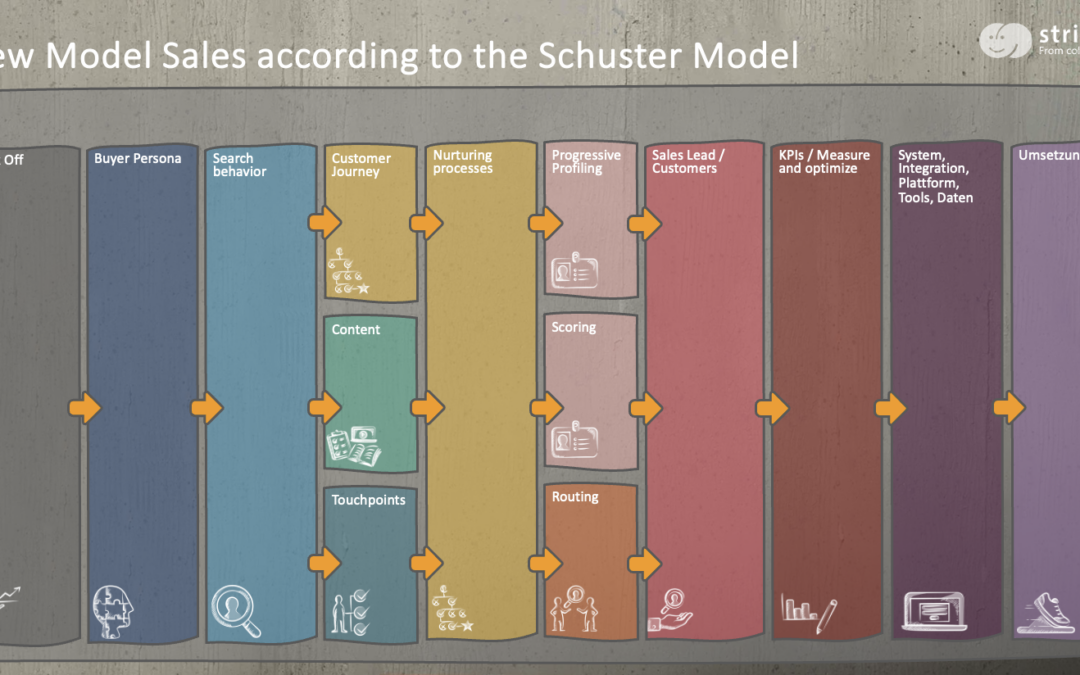How can you successfully activate the potential of digitalisation in marketing and sales? How do you successfully introduce modern lead management, existing customer management and marketing automation?
As so often in life, it makes sense to proceed with a goal-oriented strategy.
What is a strategy? The strategy answers the questions:
How do we achieve our sales targets?Who do we want to sell what to?What factors do we need to take into account?Which measures do we combine and how?Which processes, content modules and touchpoints do we use and how?What do we prioritise, what do we de-prioritise and what do we not do at all?A strategy is a plan for achieving the company's goals. ...
Important for strategy development:
Digital sales is NOT an IT project! So develop your digital strategy and only then deal with systems, tools and platforms!Every content module and every touchpoint should have a goal and a task!Avoid operational elements and concerns too early in the strategy phase! (Walt Disney method)!Strategy is important, but you shouldn't plan forever. At a certain point, you should start pragmatically - with the strategy you have created!
This canvas model is the result of many years and many projects of experience. It describes the sequence and modules of the strategy development process. Even if the environment and customer structure of my customers are different, the canvas model is a target-orientated approach model. This canvas model is the basis for my strategy development process.
These are the modules:

Kick-off introduction and stocktaking
To kick off digitalisation in marketing and sales, we bring everyone involved up to speed, take stock and define the goals and roadmap. Everyone involved should understand and be able to assess the momentum of digitalisation and marketing automation. All relevant information about structures, goals, challenges, processes, systems, touchpoints, content modules and data is recorded in the inventory.

Buyer persona – profiling your ‘ideal’ prospects or desired customers
Buyer persona profiles are the basis for the approach, content and processes of your digital processes and personalised sales support. But only if they are detailed. With detailed ‘deep buyer persona’ profiles, you build empathy for leads and customers. Based on these profiles, you can set up approaches, content modules and nurturing processes that develop leads and reactivate existing customers. In addition to the profile data, the buyer persona profiles must capture extended data (pain points, target states, decision criteria, obstacles, ‘jobs to be done’, KANO model) and behavioural preferences (DISG, INSIGHTS MDI®). The creation of buyer persona profiles with marketing, sales, service and, if applicable, product management is also a good basis for optimising cooperation between the departments.

Search behaviour: Inbound SEO / keyword analysis
How do your ideal customers search and how can you optimise your presence and content to be found better? Based on the detailed buyer persona profiles, the SEO experts check the optimisation potential for search engine optimisation, keyword strategy, on-page and off-page measures. An important aspect of this module is also to analyse how the competition is positioned online, how SEO is optimised and which keywords are being used.

Content – content and added value
What content is relevant, helpful or entertaining for your desired customers? Content is the fuel for all activities in the digital process. However, it must be relevant, helpful or entertaining for the desired customers being addressed. However, many companies create and place content that is not suitable for the desired customers and their stage in the purchasing process. The content predominantly deals with the provider and their offer (keyword ‘ego posting’). For lead generation, however, it is much more effective to offer content that addresses the pain points and interests of your desired customers (buyer persona) and matches their stage in the purchasing process. Each content module should have a task and a goal.

Touchpoints – customer contact points of the defined buyer persona
At which customer contact points can you find your ideal customers? Touchpoints are the customer contact points at which desired customers can be reached. In the touchpoint analysis, we look at the existing prospective customer and customer contact points – such as your website, blog, newsletter, LinkedIn profile, social media presence, specialist portals, etc. – and check them for buyer persona suitability. These findings are used to create a roadmap for future performance activities.

Customer journey / nurturing processes – developing prospects and customers
What does the buying journey of your ideal customers look like and how do you set up automated development processes? Based on the findings of the previous steps, we analyse the customer journey of your prospects and existing customers. On this basis, we create processes to/for …
develop new prospects to sales maturity to accompanyexisting customers to repurchaseAfter-sales - maintenance, training, consumables, etc.Cross-selling and up-sellingB and C customer careAccount based marketingRecommendationsPreventing customer lossFollow up / accompany events...
Lead routing / Service Level Agreement (SLA)
How do you route prospects to sales? Parameters must be defined for the transfer of prospects from marketing to sales and the co-operation between the two areas:
Maturity level and handover point (MQL / MQN)Assignment of leads to an area or sales employeeScope / content of the transferdata System integrationsMarketing Automation / CRM / ERP / etc. with iPaas solutionsServiceLevel AgreementClosed loop reportingMetrics and KPIsetc.

Leads in sales
How are developed leads followed up in sales? Sales must continue to manage the lead at the level to which it was developed through the digital nurturing process. By profiling your desired customers and developing your prospects or existing customers through nurturing processes, sales receives significantly more qualified and higher-quality leads. However, these leads have generally not yet made a purchase. Your sales team must continue to optimally manage, develop and qualify these leads. To be able to optimally manage these leads and lead them to a sale, they need to know the history of these leads. They need to know the persona profiles, the content used and the processes in order to be optimally prepared for contact and support.

Metrics – measure and optimise
How do you know if your digital sales strategy is successful? Digital processes in marketing and sales offer a wide range of parameters, measuring points and opportunities to measure and evaluate activities and derive measures. It is particularly important for the pilot project to establish a manageable metric that can be used to optimise the process.

Selection of marketing automation platform, CRM and tools
Which systems, tools and platforms do you need to implement your digital sales strategy? Once the aforementioned steps of the strategy have been worked out, it is the right time to think about technology, tools, assistants (e.g. AI assistants) and integration options. There are suitable platforms for all company sizes, organisational structures, requirements and budgets. Important aspects when selecting a suitable platform are
Scope of servicesComplexity / user-friendlinessLocation of data storageCompliance with legal requirementsIntegration options / API / iPaaSPriceService and supportCommitment to one technology or system environment
It does not always make sense to make the choice of platform dependent on existing system environments. It can sometimes be more expedient to connect a ‘non-system’ tool via an integration platform in ‘best of breed’ mode if it is a better fit in terms of functionality or handling.

Realisation
How do you start implementing your digital sales strategy? The following aspects, among others, are important when implementing the strategy:
Expertise in the teamCosts / budgetLegal aspects (GDPR, opt-in, etc.)Technical aspects (systems, integration options, etc.)Data management (data quality, data enrichment, data consistency, data analysis, etc.)Project managementPeople in the digital transformation (change management, etc.)
Conclusion:
A targeted digital strategy is crucial for activating the opportunities of digital transformation and optimising your sales success.


